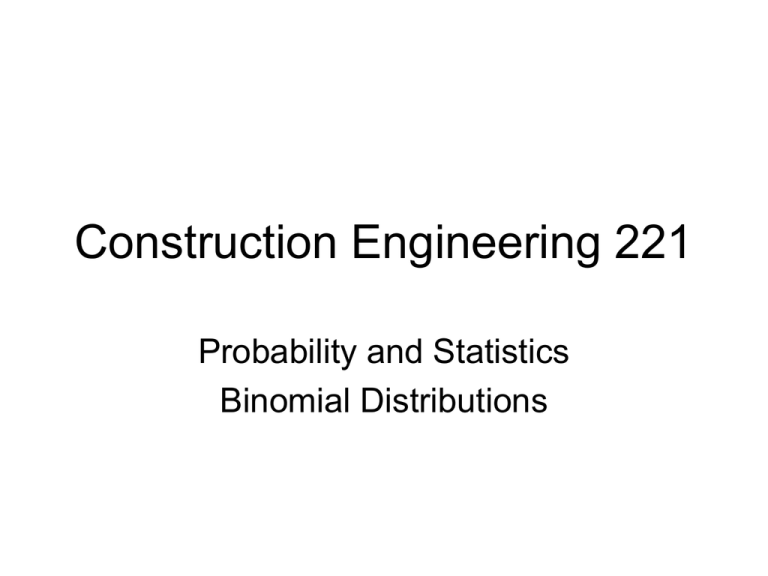Construction Engineering 221 Probability and Statistics Binomial Distributions
advertisement

Construction Engineering 221 Probability and Statistics Binomial Distributions Binomial Distribution • The binomial distribution is a discrete probability distribution • The binomial distribution is appropriate for modeling decision-making situations • There can only be TWO possible outcomes (yes/no; pass/fail) • Outcomes have to be mutually exclusive • Outcomes in the series of trials are independent events Binomial Distribution • Probability of success (yes, pass) is denoted by constant p (stationary process) • Process is called Bernoulli process • Binomial distribution used to determine probability of obtaining a designated number of successes (passes) Binomial Distribution • Three inputs required: – Designated number of passes X – Number of trials or observations n – Probability of pass for each trial p – Probability of fail is q = (1-p) • Probability of a designated number of passes is denoted as P(X/n,p) = n!/X!(n-X)! *pXqn-X Binomial Distribution • Example- The probability that a randomly chosen weld will pass inspection is .90. If an inspector checks 15 welds, the probability that exactly 14 will pass is: P(X=14/n=15, p=.9) = 15!/14!(15-14)! * (0.9)14(0.1)1 = 1.3077 X 1012/8.7178X1010 * .2288 *.1 =1.5 *.2288 * .1 = .0343 or 3.4% Binomial Distribution • To determine the cumulative probability (X or more; X or fewer), the probability of each outcome must be determined and the probabilities summed • The binomial variable X can be expressed as a proportion (percentage of passes): ˆP = X/n Formula as a proportion is same Binomial Distribution • When number of observations n is large, and probabilities p or q are small, the Poisson distribution is a suitable approximation or the binomial distribution • Rule of thumb is n>30, and n*p or n*q<5 • When n is large, but n*p or n*q is less than 5, the normal distribution is a close approximation of binomial probabilities Binomial Distribution • Binomial probabilities can be represented by tree diagrams (P=pass, F=fail) .9 P P .9 .1 P .9 F .9 .1 .9 P F .9 F .1 .1 F F .0810 P .1 .729 .081 .009 P .081 F .009 P .009 .9 .1 .1 F .001 Sum of all probabilities must equal 1.0








